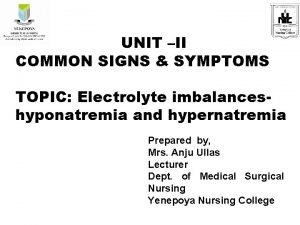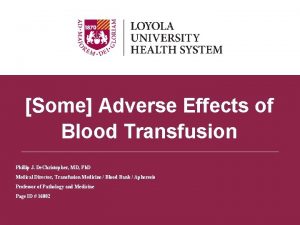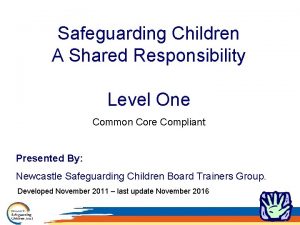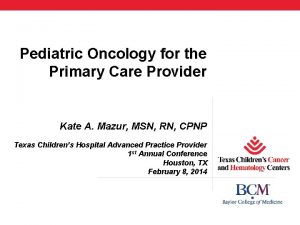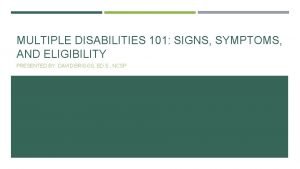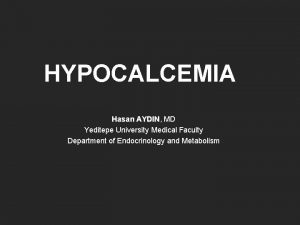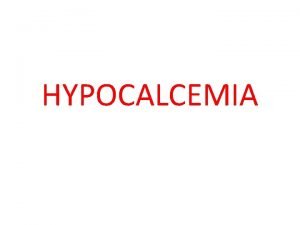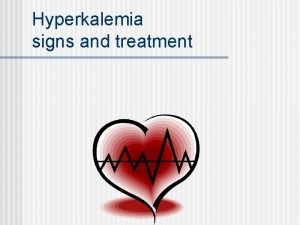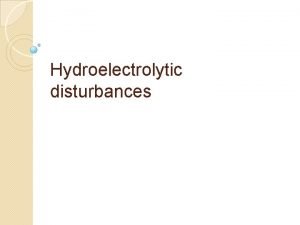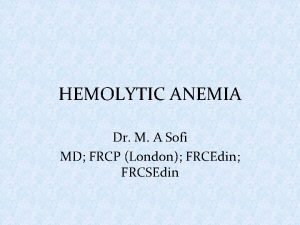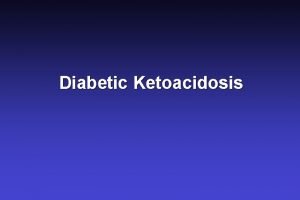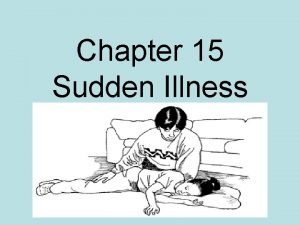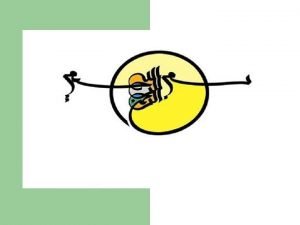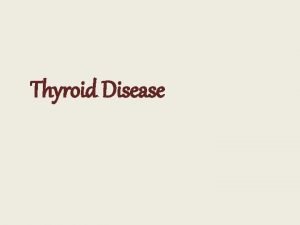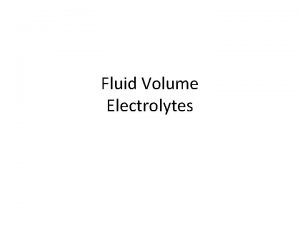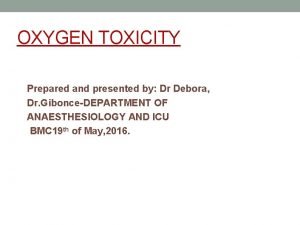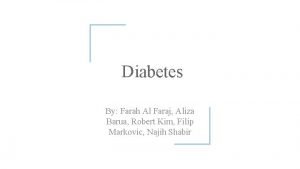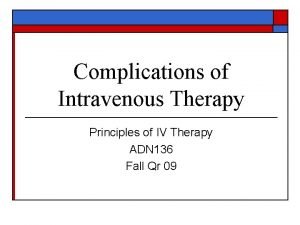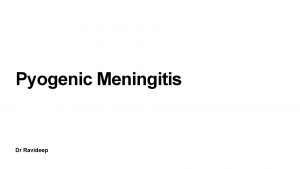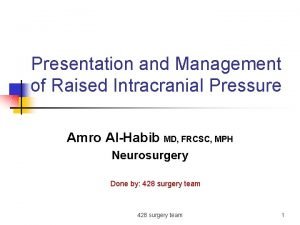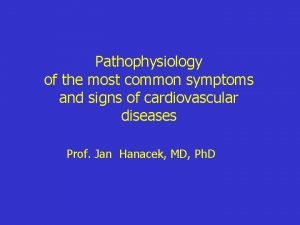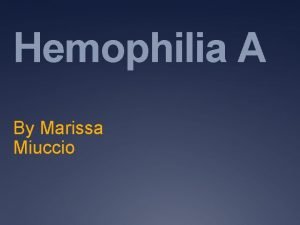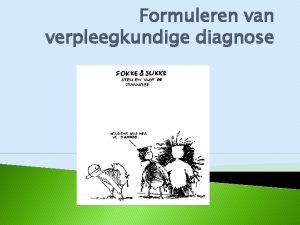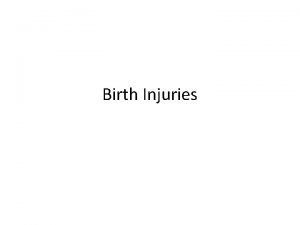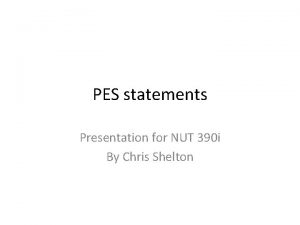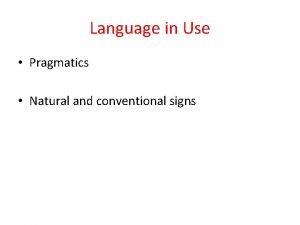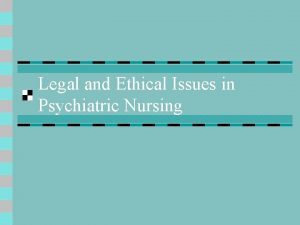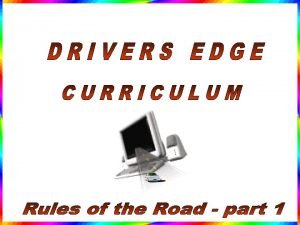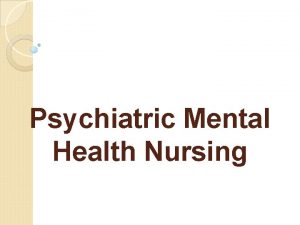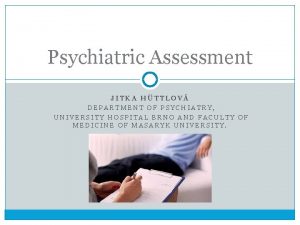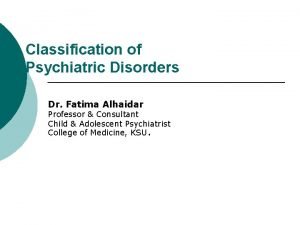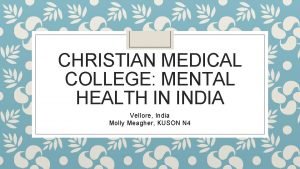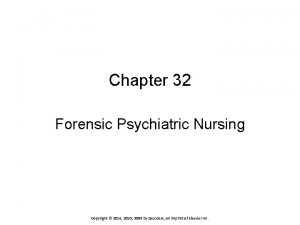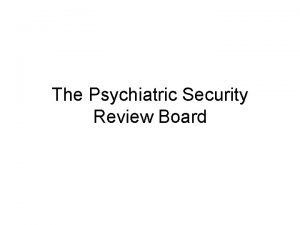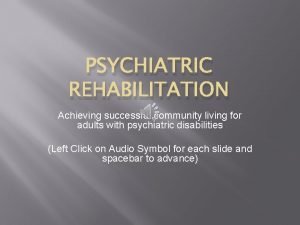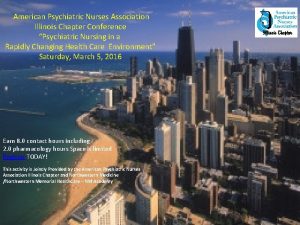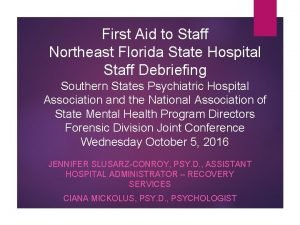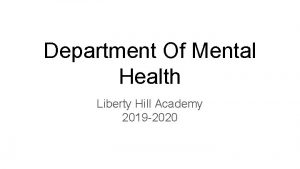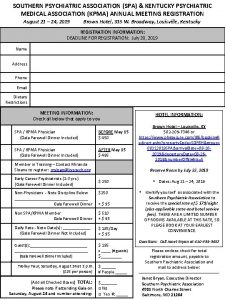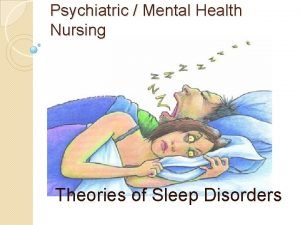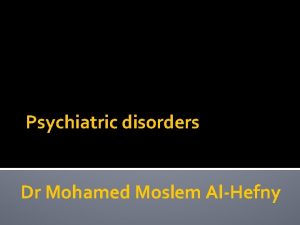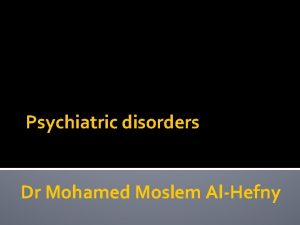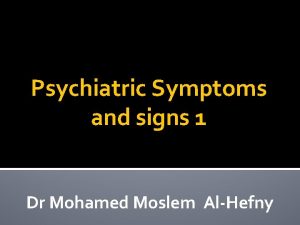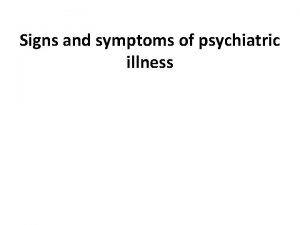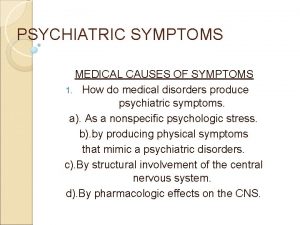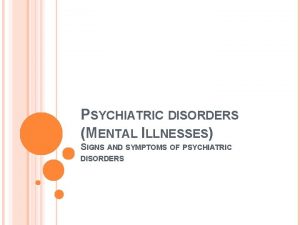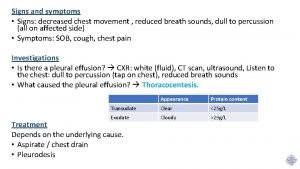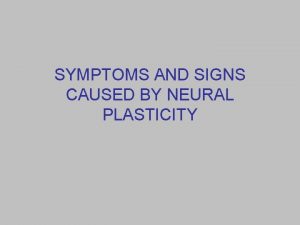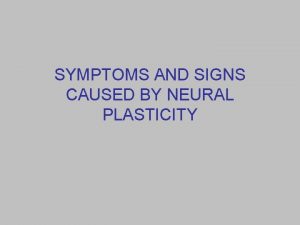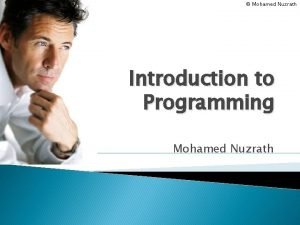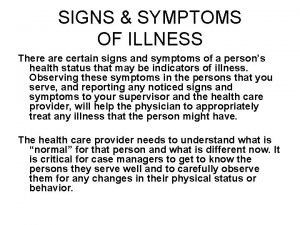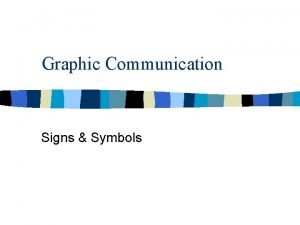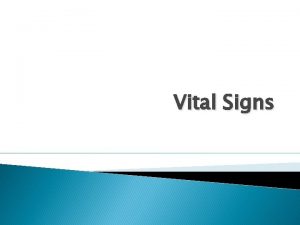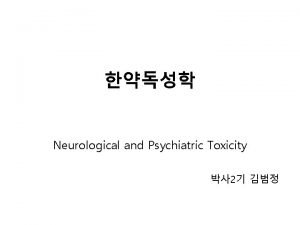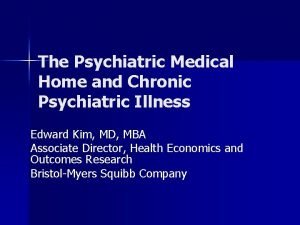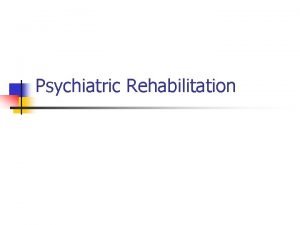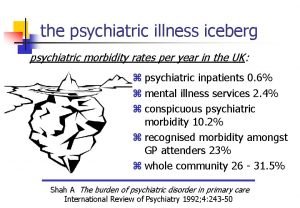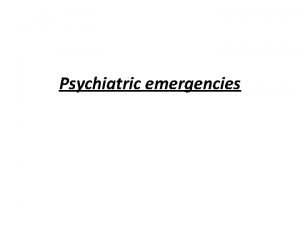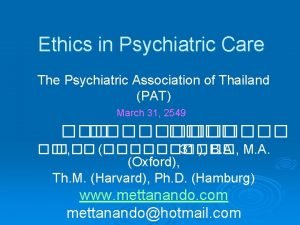Psychiatric Symptoms and signs Dr Mohamed Moslem AlHefny


















































- Slides: 50

Psychiatric Symptoms and signs Dr Mohamed Moslem Al-Hefny

Psychiatric symptoms and signs � Abnormalities of thinking � Abnormalities of perception � Abnormal behaviours q Psychotic symptoms � Mood symptoms Ø Depressive symptoms Ø Manic symptoms � Suicide / Homicide � Vegetative symptoms: � Catatonic features � Anxiety symptoms � ADHD symptoms � Eating disorders symptoms

Abnormalities of thinking 1. 2. 3. 4. Abnormalities of content of thinking Abnormalities of control of thinking Abnormalities of flow of thinking Abnormalities of form of thinking

Abnormalities of content of thinking �Delusions (in psychosis) �Obsessions �Phobias �Overvalued ideas �Anxious apprehension �Depressive rumination �Memory flashbacks (in PTSD) �Preoccupations

Delusions Definition �It is a false fixed belief not corrected by reasoning, not shared by others.

Delusions Types of delusions �Delusion of persecution : delusions that one is being attacked, cheated or persecuted. ü Robbed ü Poisoning ü Reference (the patient knows that people are talking about him, or slandering him) �Grandiose delusion: delusions of inflated worth, power, knowledge, identity, or special relationship to or famous person

Delusions Types of delusion �Erotomanic delusions (delusions of love): delusions that another person, usually of higher status, is in love with the individual. �Delusion of infidelity (jealous): delusions that the individual's sexual partner is unfaithful

Delusions Types of delusion � Delusion of poverty : The patient with delusions of poverty is convinced that they are impoverished and believe that destitution is facing them and their family. � Delusion of ill health (somatic delusions): delusions that the person has some physical defect or general medical condition � Delusion of guilt : In mild cases of depression the patient may be somewhat self-reproachful and self-critical. In severe depressive illness self-reproach may take the form of delusions of guilt, when the patient believes that they are a bad or evil person and have destructed their family.

Delusions Types of delusion � Nihilistic delusions: Nihilistic delusions or delusions of negation occur when the patient denies the existence of their body, their mind, their loved ones and the world around them. They may assert that they have no mind, no intelligence, or that their body or parts of their body do not exist; they may deny their existence as a person, or believe that they are dead, the world has stopped, or everyone else is dead. � Bizarre delusions : a delusion that involves a phenomenon that the person's culture would regard as totally implausible

Obsessions and compulsions In obsessive compulsive disorder �Obsessions are defined by (1) and (2): Recurrent and persistent thoughts, urges, or images that are experienced, at some time during the disturbance, as intrusive and unwanted, and that in most individuals cause marked anxiety or distress. The individual attempts to ignore or suppress such thoughts, urges, or images, or to neutralize them with some other thought or action (i. e. , by performing a compulsion). �

Obsessions and compulsions �Compulsions are defined by (1) and (2): Repetitive behaviors (e. g. , hand washing, ordering, checking) or mental acts (e. g. , praying, counting, repeating words silently) that the individual feels driven to perform in response to an obsession or according to rules that must be applied rigidly. The behaviors or mental acts are aimed at preventing or reducing anxiety or distress, or preventing some dreaded event or situation; however, these behaviors or mental acts are not connected in a realistic way with what they are designed to neutralize or prevent, or are clearly excessive.

Obsessions and compulsions Obsession 1 - Contamination Compulsion 2 - Pathological Doubt : It often implies some danger of violence (e. g. , forgetting to turn off the stove or not locking a door) Obsession is followed by a compulsion of checking. The checking may involve multiple trips back into the house to check the stove, for example. Obsession is followed by: Washing (patients may literally rub the skin off their hands by excessive hand washing) Compulsive avoidance of contaminated object.

Obsessions and compulsions Obsession Compulsion 3 - Intrusive Thoughts : Such No compulsions Patients obsessed with obsessions are usually repetitious thoughts of a sexual thoughts of aggressive or sexual acts may report or aggressive act that is themselves to police or confess reprehensible to the patient. to a priest. 4 - Symmetry: It is the need for Obsession leads to a symmetry or precision. compulsion of slowness. Patients can literally take hours to eat a meal or shave their faces.

Obsessions and compulsions Obsession Compulsion In Body dysmorphic disorder Preoccupation with one or more perceived defects or flaws in physical appearance that are not observable or appear slight to others. At some point during the course of the disorder, the individual has performed repetitive behaviors (e. g. , mirror checking, excessive grooming, skin picking, reassurance seeking) or mental acts (e. g. , comparing his or her appearance with that of others) in response to the appearance concerns.

Obsessions and compulsions Obsession In hoarding disorder Compulsion Persistent difficulty discarding or parting with possessions, regardless of their actual value. This difficulty is due to a perceived need to save the items and to distress associated with discarding them. The difficulty discarding possessions results in the accumulation of possessions that congest and clutter active living areas and substantially compromises their intended use. If living areas are uncluttered, it is only because of the interventions of third parties (e. g. , family members, cleaners, authorities).

Obsessions and compulsions Obsession Compulsion In Trichotillomania (Hair-Pulling Disorder) Recurrent pulling out of one’s hair, resulting in hair loss. Repeated attempts to decrease or stop hair pulling.

Overvalued ideas Definition �This is a thought that, because of the associated feeling tone, takes precedence over all other ideas and maintains this precedence permanently or for a long period of time. DD form delusions �Overvalued ideas tend to be less fixed than delusions and tend to have some degree of basis in reality.

Overvalued ideas Causes � They can occur in individuals both with and without mental illness. 1. Personality disorders (paranoid PD with overvalued ideas of persecution; OCPD) 2. Eating disorders 3. Body dysmorphic disorder 4. Hypochondriasis (with overvalued ideas of ill health) 5. Depressive disorders (ex. overvalued ideas of ill health) 6. Gender identity disorder 7. Morbid jealousy

Preoccupations Definition �Ideas that are present most of the time and dominating thinking with quantitative difference from normal ideas. Causes �Normal (pre exam) �Somatoform disorders �Anxiety �Depression

Flashbacks Definition � Flashbacks are sudden intrusive memories that are associated with the cognitive and emotional experiences of a traumatic event such as an accident. � It may lead to acting and/or feeling that the event is recurring and attempts have been made to use this as a defence in some murder trials. Causes � It is regarded as one of the characteristic symptoms of post-traumatic stress disorder but is also associated with substance misuse disorders and emotional events

Abnormalities of control of thought �Delusion of passivity or control: a delusion in which feelings, impulses, thoughts, or actions are experienced as being under the control of some external force rather than being under one's own control.

Abnormalities of control of thought Made affect (someone controlling the mood/affect). 2. Made volition (someone controlling the action). 3. Made impulse (someone controlling the desire to act) 4. Made thoughts: A. Thought withdrawal. B. Thought insertion. 1. �Thought broadcasting “people act as if they know what I'm thinking”.

Abnormalities of form of thought Formal thought disorders (FTD) or disorganized speech �How to assess the thought process (form)? ü Goal directedness. ü Association between words, phrases, sentences & paragraphs. ü Rate, amount & rhythm of speech. ü Idiosyncrasy of word usage.

Abnormalities of form of thought �Normal thought process? ü Goal directed (direct). ü To the point. ü Good connection between elements of structure of the thought (words, sentences and paragraphs). ü No idiosyncratic use of words.

Abnormalities of form of thought � FTD include: q Abnormalities of Goal directedness Circumstantiality: ü overinclusion of details not directly relevant to the question ü the sequential states are connected ü the patient eventually returns to address the subject or address the question Tangentiality: ü The patient never returns to the original point of question ü The thought are irrelevant and related in a minor insignificant manner

Abnormalities of form of thought �FTD include: q Abnormalities of Association �Loosening of association: (difficult or impossible to see connections between thoughts) �Incoherence (word salad, schizophasia): extreme loss of association �Clang associations (association based on alliteration rhyming or assonance) ﻣﻮﺳﻴﻘﻰ �Punning (association by double meaning) ﺳﺠﻊ

Abnormalities of form of thought �FTD include: q Idiosyncratic use of language (private symbolism) Neologism Cryptolalia = the use of obscure (or private) language

Abnormalities of form of thought � FTD include: q Repetition � Stereotypy (vocal and verbal) (repetitive or ritualistic utterance) � Verbigeration (repetition of stereotyped phrases) � Perseveration (repetition of word or phrase despite the absence or cessation of a stimulus) � Echolalia (repetition of words spoken by others) � Palilalia (auto-echolalia) � Logoclonia (repetition of the last syllable of a word) � Coprolalia (repetition of obscene language)

Abnormalities of flow of thought �Flight of ideas: rapid rated speech, frequent shifts in topics, in manic patient. �Slow stream in depression �Thought block: in schizophrenic patient.

Abnormalities of perception �Disorders of perception can be divided into 1. Sensory distortions: there is a constant real perceptual object, which is perceived in a distorted way. 2. Sensory deceptions: a new perception occurs that may or may not be in response to an external stimulus.

Sensory distortions �Sensory distortions: These are changes in perception that are the result of a change in the intensity and quality of the stimulus or the spatial form of the perception. 1. Changes in intensity 2. Changes in quality 3. Changes in spatial form (dysmegalopsia)

Sensory distortions �Changes in intensity Ø Increased intensity of sensations o Ex. migraine is associated with increased sensitivity to noise (hyperacusis) Ø Decreased intensity of sensations o Ex. Hypoacusis occurs in delirium

Sensory distortions �Changes in quality Ø Ex. Colouring of yellow, green and red. These are mainly the result of drugs (for example, digitalis) �Changes in spatial form Ø Micropsia is a visual disorder in which the patient sees objects as smaller than they really are. Ø Macropsia is a visual disorder in which the patient sees objects as larger than they really are.

Sensory deceptions �These can be divided into 1. Illusions = misinterpretations of stimuli arising from an external object. 2. Hallucinations = perceptions without an adequate external stimulus.

Hallucination Definition: �Perception without actual stimulus present �They care from <within> although the subject reacts if they were true preceptors coming from < without> DD from illusions �Hallucination: no actual stimulus �Illusions: with actual stimulus

Hallucination Types �Auditory hallucination: �Elementary: noises �Partly organized: music �Completely organized: hallucinatory voice Commanding , ordering, threatening, praising, abusive, audible thought �Visual hallucination: �Elementary: flashes of light �Partly organized �Completely organized: vision of people, animals

Hallucination �Olfactory hallucinations: smell �Gustatory hallucinations: taste �Tactile hallucinations: sexual hallucinations �Hallucination of pain, deep sensation

Abnormal behaviours � Manic and impulse control disorder pleasure seeking behavior � Histrionic attention seeking behavior � SUD drug seeking behavior � Psychotic disorganized or bizarre behavior (collecting things from the floor) � Catatonia catatonic behavior � Unexplained behavior � Disinhibited behavior [socially, sexually] � Autism Ritualistic behaviour � Autism Stereotyped behaviour � Stereotyped behavior (due to any cause) � Impulsive behavior � Manipulative behavior

Abnormal behaviours � Compulsive/ ritualistic behavior � Aggressive/violent behavior � Antisocial/conduct behavior � Oppositional/defiant behavior � Psychotic with hallucinations hallucinatory behavior � Maladaptive behavior � Suicidal/homicidal behavior � BPD self mutilating behavior � Sexually abused child oversexualized/sexual promiscuity behavior � GID Cross gender identification behavior [cross dressing, play, games & activities]

Abnormal behaviours �Catatonic behaviours �Excessive motor activity (excitement) �Peculiarities of voluntary movement ü Posturing ü Stereotyped movements ü Prominent mannerisms ü Prominent grimacing �Echopraxia �Motoric immobility ü Stupor ü Catalepsy (including waxy flexibility) �Extreme negativism

Psychotic symptoms �Positive symptoms ü Delusion ü Hallucination ü Incomprehensible speech (disorganized speech) ü Disorganized behaviors ü Catatonic behaviours �Negative symptoms

Mood symptoms Mood �Mood is a pervasive and sustained emotion that colours the person’s perception of the world. Affect �Affect, meaning short-lived emotion, is defined as the patient’s present emotional responsiveness. It is what the doctor infers from the patient’s body language including facial expression and it may or may not be congruent with mood.

1 - Depressive symptoms �Depressed mood �Loss of interest (markedly diminished interest or pleasure in all, or almost all, activities most of the day, nearly every day (as indicated by either subjective account or observation made by others) �Guilt feeling �Feelings of worthlessness �Lack of concentration �Lack of energy �Psychomotor agitation/retardation

2 - Manic symptoms � Elevated mood � Inflated esteem / Grandiosity � More talkative than usual or pressure to keep talking � Flight of ideas � Distractibility (i. e. , attention too easily drawn to unimportant or irrelevant external stimuli) � Increase in goal-directed activity (either socially, at work or school, or sexually) or psychomotor agitation � Excessive involvement in pleasurable activities that have a high potential for painful consequences (e. g. , engaging in unrestrained buying sprees, sexual indiscretions, or foolish business investments)

Suicide / Homicide �Death thoughts �Death wishes �Suicidal ideation �Suicidal intent �Suicidal plan �Suicidal attempt

Vegetative symptoms: � � Appetite and Weight Sleep Sex Self hygiene

Anxiety symptoms �Generalized Anxiety Disorder �Panic disorder: somatic symptoms, agoraphobia �Social anxiety disorder: symptoms �Simple phobias

Eating disorders symptoms: �Binge eating �Purging �Excessive fasting or exercise

Major psychiatric disorders �Psychotic Disorders (schizophrenia) �Mood Disorders (depression, bipolar) �Anxiety Disorders �Dissociative Disorders �Obsessive Compulsive Disorders �Psychosomatic (Somatoform) Disorders �Eating Disorders �Sexual Disorders �Substance use disorders �Personality disorders �Childhood psychiatry (Autism, ADHD)

Thank you
 All traffic signs and meanings
All traffic signs and meanings Pregnant or period
Pregnant or period Hyperkalemia signs and symptoms
Hyperkalemia signs and symptoms Sexual abuse signs and symptoms
Sexual abuse signs and symptoms Taco trali
Taco trali Symptoms of shock
Symptoms of shock Victoria climbe
Victoria climbe Kate
Kate Signs and symptoms of multiple disabilities
Signs and symptoms of multiple disabilities Trousseau sign
Trousseau sign Hypocalcemia signs and symptoms
Hypocalcemia signs and symptoms Management of hyperkalemia
Management of hyperkalemia Low potassium symptoms
Low potassium symptoms Chronic hemolysis
Chronic hemolysis Dka signs and symptoms
Dka signs and symptoms Signs and symptoms of sudden illness
Signs and symptoms of sudden illness Coma sign
Coma sign Hyperkalemia and muscle weakness
Hyperkalemia and muscle weakness Signs and symptoms of trali
Signs and symptoms of trali Myxedema coma signs and symptoms
Myxedema coma signs and symptoms Hypokalemia signs and symptoms
Hypokalemia signs and symptoms Signs and symptoms of oxygen toxicity
Signs and symptoms of oxygen toxicity Signs and symptoms of hyperglycemia
Signs and symptoms of hyperglycemia Phlebitis vs infiltration treatment
Phlebitis vs infiltration treatment Meningitis symptoms baby
Meningitis symptoms baby Icp
Icp Pathophysiology signs and symptoms
Pathophysiology signs and symptoms Haemophilia a
Haemophilia a Pes verpleegkundige diagnose
Pes verpleegkundige diagnose Caput succedaneum
Caput succedaneum Underweight pes statement
Underweight pes statement Conventional sign example
Conventional sign example Ethical and legal issues in psychiatric nursing
Ethical and legal issues in psychiatric nursing The diamond shape is used exclusively for _____ signs.
The diamond shape is used exclusively for _____ signs. The diamond shape is used exclusively for _____ signs
The diamond shape is used exclusively for _____ signs Definition of psychiatric nursing
Definition of psychiatric nursing Mse psychiatry
Mse psychiatry Ineffective childbearing process example
Ineffective childbearing process example History of psychiatric nursing
History of psychiatric nursing Psychological disorders
Psychological disorders Cmc psychiatric hospital
Cmc psychiatric hospital Role of psychiatric nurse
Role of psychiatric nurse The term behavioral crisis is most accurately defined as
The term behavioral crisis is most accurately defined as Psychiatric security review board
Psychiatric security review board Psychiatric rehabilitation
Psychiatric rehabilitation Psychiatric nurse conference
Psychiatric nurse conference American psychiatric association annual meeting 2020
American psychiatric association annual meeting 2020 Northeast florida psychiatric associationinc
Northeast florida psychiatric associationinc Psychiatric services liberty hill
Psychiatric services liberty hill Southern psychiatric association
Southern psychiatric association Remalteon
Remalteon


